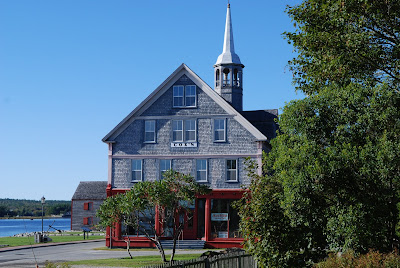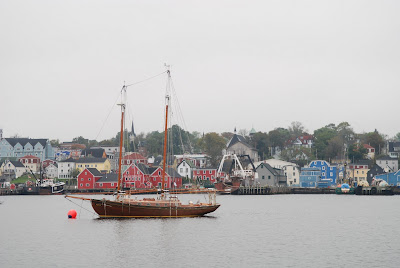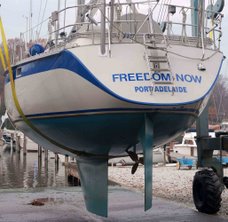skip to main |
skip to sidebar
 Shelburne is another cruisers delight. The yacht club welcomes visitors with open arms, showers and bar. Nothing is too much trouble for them. The town is steeped in history with buildings to match. Settled in 1783 by British Loyalists fleeing the American Revolution it was ironically named Shelburne after the Prime Minister of England who caved in to the revolutionaries. Many of the oldest buildings have been restored and in 1993 was further restored so that it could be used as a location for the movie "Scarlet Letter". The very first people we met said "You must have a meal at "Charlotte Lane" restaurant, the food is superb." We had similar recommendations from everyone else we met that day. It was Sunday and we attended worship at the United Church, with yet another female minister and wonderful music including a hand bell offertory. Then we set off for "Charlotte Lane" only to discover that it is closed on Sunday and Monday, the only two days we felt we could afford to spend in Shelburne. Expressing our disappointment out loud to a local woman we were invited next door to her home. She and her husband moved to Shelburne a few years ago and have set up a workshop where Forbes makes the most beautifully crafted wooden flutes we have ever seen. On their recommendation we headed for the local bakery to enjoy our first "Reuben", (grilled rye bread with Pastrami, sour kraut and Swiss cheese). Bonnie liked it so much that she is determined to add it to her culinary creations. Dinner guests beware.
Shelburne is another cruisers delight. The yacht club welcomes visitors with open arms, showers and bar. Nothing is too much trouble for them. The town is steeped in history with buildings to match. Settled in 1783 by British Loyalists fleeing the American Revolution it was ironically named Shelburne after the Prime Minister of England who caved in to the revolutionaries. Many of the oldest buildings have been restored and in 1993 was further restored so that it could be used as a location for the movie "Scarlet Letter". The very first people we met said "You must have a meal at "Charlotte Lane" restaurant, the food is superb." We had similar recommendations from everyone else we met that day. It was Sunday and we attended worship at the United Church, with yet another female minister and wonderful music including a hand bell offertory. Then we set off for "Charlotte Lane" only to discover that it is closed on Sunday and Monday, the only two days we felt we could afford to spend in Shelburne. Expressing our disappointment out loud to a local woman we were invited next door to her home. She and her husband moved to Shelburne a few years ago and have set up a workshop where Forbes makes the most beautifully crafted wooden flutes we have ever seen. On their recommendation we headed for the local bakery to enjoy our first "Reuben", (grilled rye bread with Pastrami, sour kraut and Swiss cheese). Bonnie liked it so much that she is determined to add it to her culinary creations. Dinner guests beware.  We loved Shelburne and were tempted to stay longer than two days but the weather pattern was good and we were running out of warm sunny days. Several other boats were leaving to sail to Maine and as one was leaving the dock Bonnie and I sang them off with our Farewell Sea Shanty. We now faced another formidable passage requiring us to sail overnight around the foot of Nova Scotia, noted for its strong currents, and across the Bay of Fundy where the biggest tidal range in the world occurs. One tidal station records rises exceeding 16 metres several times a year. We needed to get it right.
We loved Shelburne and were tempted to stay longer than two days but the weather pattern was good and we were running out of warm sunny days. Several other boats were leaving to sail to Maine and as one was leaving the dock Bonnie and I sang them off with our Farewell Sea Shanty. We now faced another formidable passage requiring us to sail overnight around the foot of Nova Scotia, noted for its strong currents, and across the Bay of Fundy where the biggest tidal range in the world occurs. One tidal station records rises exceeding 16 metres several times a year. We needed to get it right.
 The sailing and navigating to Lunenburg was easy, gentle breezes and smooth seas. Before we arrived in the entrance of the harbour a mist had rolled in and we were greeted by a fleet of schooners. It was the day of the annual schooner race. They presented a wonderful sight. We were able to sail right into the harbour and just as we entered we were greeted by the most famous of all the schooners Bluenose 11 as she left with a load of paying customers. She is a replica of the original Bluenose Schooner whose image graces the Canadian dime. Launched in 1921 as a fishing schooner she was designed to be not only a grand banks fishing boat but also the fastest working schooner the world had ever seen. The America's Cup was regarded as something for sissies and only sailed in light winds. This was a boat for all seasons and out sailed every other working schooner ever built. She was unbeaten in her home waters. She was eventually sold and wrecked on the shoals of Haiti. During her quarter of a century as the Queen of the ocean she had caught the imagination of people around the world. The replica that greeted us was built in Lunenburg at the same shipyard as the original and although it is debated by some of the locals she is as close as possible an exact copy of the original and a truly magnificent sight. We were in Lunenburg for 6 days and every day we went ashore in our dinghy we tied up at a dinghy dock alongside Bluenose 11 and never ceased to lose our awe at the sheer beauty of her lines.
The sailing and navigating to Lunenburg was easy, gentle breezes and smooth seas. Before we arrived in the entrance of the harbour a mist had rolled in and we were greeted by a fleet of schooners. It was the day of the annual schooner race. They presented a wonderful sight. We were able to sail right into the harbour and just as we entered we were greeted by the most famous of all the schooners Bluenose 11 as she left with a load of paying customers. She is a replica of the original Bluenose Schooner whose image graces the Canadian dime. Launched in 1921 as a fishing schooner she was designed to be not only a grand banks fishing boat but also the fastest working schooner the world had ever seen. The America's Cup was regarded as something for sissies and only sailed in light winds. This was a boat for all seasons and out sailed every other working schooner ever built. She was unbeaten in her home waters. She was eventually sold and wrecked on the shoals of Haiti. During her quarter of a century as the Queen of the ocean she had caught the imagination of people around the world. The replica that greeted us was built in Lunenburg at the same shipyard as the original and although it is debated by some of the locals she is as close as possible an exact copy of the original and a truly magnificent sight. We were in Lunenburg for 6 days and every day we went ashore in our dinghy we tied up at a dinghy dock alongside Bluenose 11 and never ceased to lose our awe at the sheer beauty of her lines.  There is more to Lunenburg than the Bluenose 11. When Cornwallis established Halifax as a British harbour in 1749 he decided that the settlers already living there who were not British should be moved so 453 people (about two-thirds German, one third French and Swiss) were transported to Lunenberg so named to honour George II of England who as Elector of Hanover held the Duchy of Lunenburg in Germany.Many of the buildings hold a charm and character of old Europe, the protestant churches including a large Lutheran church dominate the skyline and the surnames of the residents still contain many straight from a German or French phone directory. Our shaken down motor was checked by a mechanic named Knickle a direct descendant from an original German family.We enjoyed a lamb barbecue to celebrate the end of the schooner race, visited numerous galleries, cafes and churches including the magnificent Anglican church rebuilt after a fire in the original carpentry Gothic style. There we shared in an hour of pipe organ recital and hymns.We spent considerable time with Keith and Ann who now had their boat Ketchup II in the boat yard with two big holes in the hull and all the hassles of trying to get the right epoxy bond and plaster work done to repair her ferro cement hull. They had run foul of some uncharted rocks further up the coast. They have created a stir among the Canadian Hydrography Department.We needed to press on and thought we would sail to Port Mouton so named because Champlain lost a sheep overboard there in 1604. The winds were too good for that so at the last minute we decided to sail straight through to Shelburne. We were hitting 8 knots or more in NW breeze of 20-25 knots and picked up a mooring at the Shelburne Yacht Club just before dark having travelled 85 nautical miles in less than 12 hours.
There is more to Lunenburg than the Bluenose 11. When Cornwallis established Halifax as a British harbour in 1749 he decided that the settlers already living there who were not British should be moved so 453 people (about two-thirds German, one third French and Swiss) were transported to Lunenberg so named to honour George II of England who as Elector of Hanover held the Duchy of Lunenburg in Germany.Many of the buildings hold a charm and character of old Europe, the protestant churches including a large Lutheran church dominate the skyline and the surnames of the residents still contain many straight from a German or French phone directory. Our shaken down motor was checked by a mechanic named Knickle a direct descendant from an original German family.We enjoyed a lamb barbecue to celebrate the end of the schooner race, visited numerous galleries, cafes and churches including the magnificent Anglican church rebuilt after a fire in the original carpentry Gothic style. There we shared in an hour of pipe organ recital and hymns.We spent considerable time with Keith and Ann who now had their boat Ketchup II in the boat yard with two big holes in the hull and all the hassles of trying to get the right epoxy bond and plaster work done to repair her ferro cement hull. They had run foul of some uncharted rocks further up the coast. They have created a stir among the Canadian Hydrography Department.We needed to press on and thought we would sail to Port Mouton so named because Champlain lost a sheep overboard there in 1604. The winds were too good for that so at the last minute we decided to sail straight through to Shelburne. We were hitting 8 knots or more in NW breeze of 20-25 knots and picked up a mooring at the Shelburne Yacht Club just before dark having travelled 85 nautical miles in less than 12 hours.
 It seemed strange but we both felt very sad to be leaving Baddeck. We had loved the culture, the people and its scenic beauty. We had made good friends, attended worship at the United Church, attended a choral singing workshop, been visited by Karen, their minister, loaned a private car to tour the Cape Breton trail and received excellent service from everyone. Even strangers would greet us in the street with a cheery, "Hello, you're still here?"The motor arrived back in the nick of time as there was a gale warning out for the Saturday with winds SE 45 knots. Had we remained on the dock we would have been severely battered against it. The motor was installed on Friday afternoon but we had difficulty starting it. Sparks were seen to be flying out from under the exhaust box. The mechanic lifted the box to discover that the main positive cable to the starting motor had corroded to copper oxide with only two strands of the cable still intact. It had to be replaced and it was 7pm. Bruce sent the two mechanics home and worked until 10pm. to remove the massive batteries, battery box floor and finally the offending cable so that a replacement could be fitted. Saturday morning a new cable was installed, the motor started and we were able to motor up to Herring Cove a wonderfully protected hurricane hole and dropped anchor just before the gale hit. The next day we motored back, the mechanic checked the motor on Monday and we were off down the lake through Barra Strait to drop anchor in Damien Cove. We were the only boat at anchor in the picturesque cove and as the forecast for the next day was for light winds we were keen to head south. Dense fog prevented an early start but as soon as it lifted we headed for the St Peters Canal and were through and on our way by 1100h. It was almost a dead calm so we had to give our rebuilt motor a good workout. We decided to try to get right through to Halifax by travelling through the night varying engine revs every 20 minutes to run it in. As we approached Halifax the winds picked up from the S and we were able to romp into Halifax Harbour at a boat speed of 7 to 8 knots. We refuelled and anchored off the Armdale yacht club for 3 nights until a favourable forecast motivated us to leave for Lunenburg.
It seemed strange but we both felt very sad to be leaving Baddeck. We had loved the culture, the people and its scenic beauty. We had made good friends, attended worship at the United Church, attended a choral singing workshop, been visited by Karen, their minister, loaned a private car to tour the Cape Breton trail and received excellent service from everyone. Even strangers would greet us in the street with a cheery, "Hello, you're still here?"The motor arrived back in the nick of time as there was a gale warning out for the Saturday with winds SE 45 knots. Had we remained on the dock we would have been severely battered against it. The motor was installed on Friday afternoon but we had difficulty starting it. Sparks were seen to be flying out from under the exhaust box. The mechanic lifted the box to discover that the main positive cable to the starting motor had corroded to copper oxide with only two strands of the cable still intact. It had to be replaced and it was 7pm. Bruce sent the two mechanics home and worked until 10pm. to remove the massive batteries, battery box floor and finally the offending cable so that a replacement could be fitted. Saturday morning a new cable was installed, the motor started and we were able to motor up to Herring Cove a wonderfully protected hurricane hole and dropped anchor just before the gale hit. The next day we motored back, the mechanic checked the motor on Monday and we were off down the lake through Barra Strait to drop anchor in Damien Cove. We were the only boat at anchor in the picturesque cove and as the forecast for the next day was for light winds we were keen to head south. Dense fog prevented an early start but as soon as it lifted we headed for the St Peters Canal and were through and on our way by 1100h. It was almost a dead calm so we had to give our rebuilt motor a good workout. We decided to try to get right through to Halifax by travelling through the night varying engine revs every 20 minutes to run it in. As we approached Halifax the winds picked up from the S and we were able to romp into Halifax Harbour at a boat speed of 7 to 8 knots. We refuelled and anchored off the Armdale yacht club for 3 nights until a favourable forecast motivated us to leave for Lunenburg.
 Shelburne is another cruisers delight. The yacht club welcomes visitors with open arms, showers and bar. Nothing is too much trouble for them. The town is steeped in history with buildings to match. Settled in 1783 by British Loyalists fleeing the American Revolution it was ironically named Shelburne after the Prime Minister of England who caved in to the revolutionaries.
Shelburne is another cruisers delight. The yacht club welcomes visitors with open arms, showers and bar. Nothing is too much trouble for them. The town is steeped in history with buildings to match. Settled in 1783 by British Loyalists fleeing the American Revolution it was ironically named Shelburne after the Prime Minister of England who caved in to the revolutionaries. 



